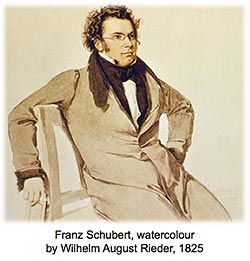Music Educators Association of New Jersey
Serving teachers and students since 1927



Daniel Epstein, international performer, teacher and recording artist began his illuminating discussion by performing the first movement of Schubert's extraordinary Sonata in B flat, D. 960, his last piano sonata. Mr. Epstein produced a beautiful singing tone in the melody.

Schubert has been compared to Beethoven, but Schubert's critics find his larger structures rambling, episodic and lacking in dramatic tension. Beethoven would build music on motives, while Schubert, "a natural," often used an improvisational style, allowing development sections to develop wildly. Schubert was known for not revising or polishing his compositions. A critic noted, " . . . some tedious passages creep in."
Considering Schubert's short life, (1797-1828), we might regard all his music as his "early works." Although known for songs and dance music, he produced much "serious music," particularly during his last five years. In 1828, while very ill, he composed his greatest masterworks, including the B Flat Piano Sonata.
Daniel Epstein discussed the B Flat Sonata from three perspectives:
(1) Mood - Schubert's artistic life; (2) Classical Style; and (3) Analysis


1. Mood. Mr. Epstein described the political, economic, and social conditions of early 19th century life in Vienna, Schubert's birthplace. Squalid living conditions existed alongside the beautiful world of the wealthy and powerful. Vienna was a walled city that had suffered nearly 150 years of constant invasion from the Ottoman Empire. During Schubert's life, political unrest continued. The dual reality of constant fear vs. the pleasures of life affected the Viennese psyche; it greatly influenced Schubert's work. This contrast is heard in "Death and the Maiden," developed from an early song he wrote at age 17 based on a poem by Claudius. In the introduction, we hear the death chords, which Mr. Epstein demonstrated. Then the maiden speaks: "Pass me by, Touch me not." Death speaks: "Give me your hand, you shall sleep softly." The death music transitions from a major key to the minor and back again, finally to the foreboding tones of D minor.

Mr. Epstein referred to the flourishing of the arts and the loosening of strictness in music in the Biedermeier Period (1815 - 1848). With the rise of the middle class, more public concerts were given. Instruments became more affordable and the piano became a status symbol. The rise of the talented amateur followed.
In Schubert's time, audiences were more attentive to longer works. Today's audiences have shorter attention spans, and different feelings and attitudes. Mr. Epstein also discussed the listener's reaction to dissonance and how tempo can affect one's perception of it.

2. Classical Style, the Sonata (Sonata-Allegro) Form. Many composers, including Mozart and Beethoven, did not always follow the conventions of sonata form: Exposition (primary theme in tonic, contrasting secondary theme in dominant or relative major) closing phrase to a double bar at the dominant or relative major: Development Section eventually returning to the tonic through its dominant chord; Recapitulation with both primary and secondary themes in the tonic; Coda (optional) The point made was that this "form" is elastic, as Schubert proved, not fixed. Charles Rosen felt that sonata form was not really a form, but more like a texture evolved from rounded binary form vs. ternary form.
3. Analysis. Schubert's B Flat Sonata contains elements of classical style, but is unique. Instead of motive, he plants sonic seeds: rhythmic or pitch/interval. "Classical" is projected to the audience but "Romantic" is the underlying communication.

There are so many ways to interpret or misinterpret Schubert. "The simplest thing can be profound" [but] when played too slow and too portentously would be overdone dramatically. Much has been written about the opening. In this periodic phrasing, with a half- cadence a bar too soon, the appearance of the G flat [trill], makes it not foreboding, but more understandable. The bass chromatic should be voiced on the upper note leading to the "heavenly part". The M 9th will be important later.
Mr. Epstein explained his fascinating, detailed analysis, omitted here. Referring to the score, he discussed themes, harmonies, progressions chromaticism, innovative enharmonic changes, melodic and rhythmic devices and more. He continued: "The development uses the triplets with repetitions and modulations, half-steps creating dissonance as drama. The arrival of a D minor dream sequence [is] a false recap in D minor. Why? The first theme in the tonic destroys the form. Don't dwell on this; it's like a fragment of a dream. The C# minor arrives in the coda and now here's that M 9th. An amazing end."
He spoke of controversies in interpretation and analysis. On musicologist Alfred Brendel's criticism of most performers for not taking the repeat, Epstein said, "I'm not going to weigh in on this." One question arose about how to play the triplets in the treble against the eighth notes in the bass. Together? Like two 1/16's + 1/8? Epstein felt they should be played traditionally to keep the inherent struggle in the rhythm.

Daniel Epstein is on the piano faculty of the Manhattan School of Music and the Mason Gross School of Music at Rutgers University. As a pianist and founding member of the Raphael Trio, he has performed virtually the entire piano trio repertoire in New York's Carnegie and Town Halls, the Kennedy Center in Washington and in London, Paris, Geneva, Budapest and other notable cultural cities. Recognized as a versatile solo/chamber pianist, as well as an articulate educator, he has given solo recitals and masters classes worldwide. Please visit: danielepsteinpiano.com.
Ruth Pasquariello, writer
Photography and layout, Nancy Modell